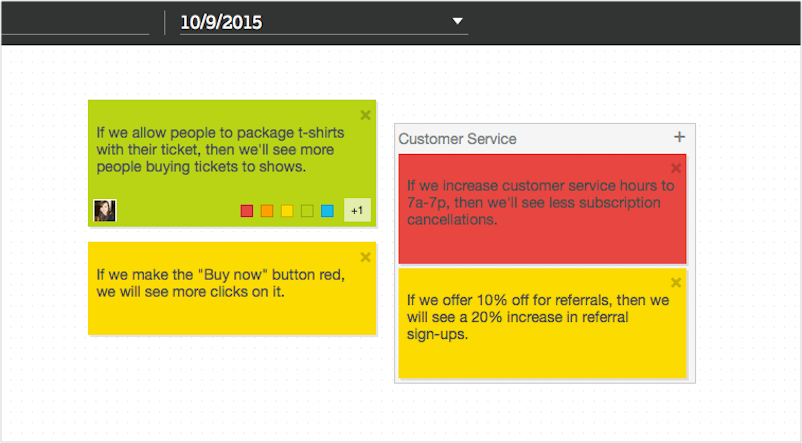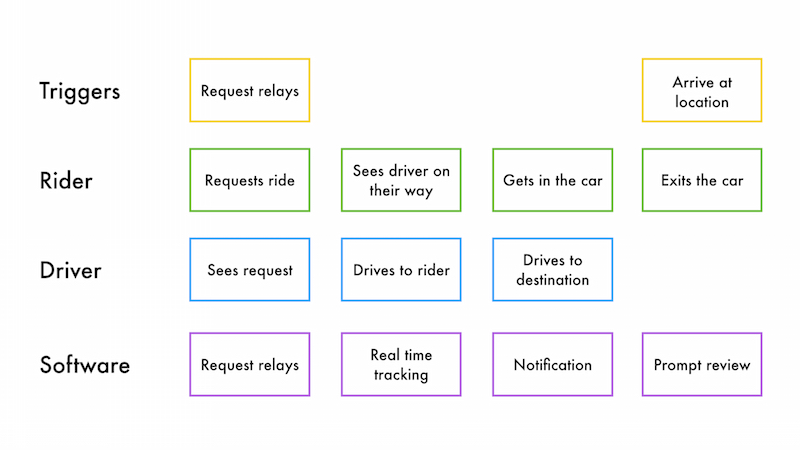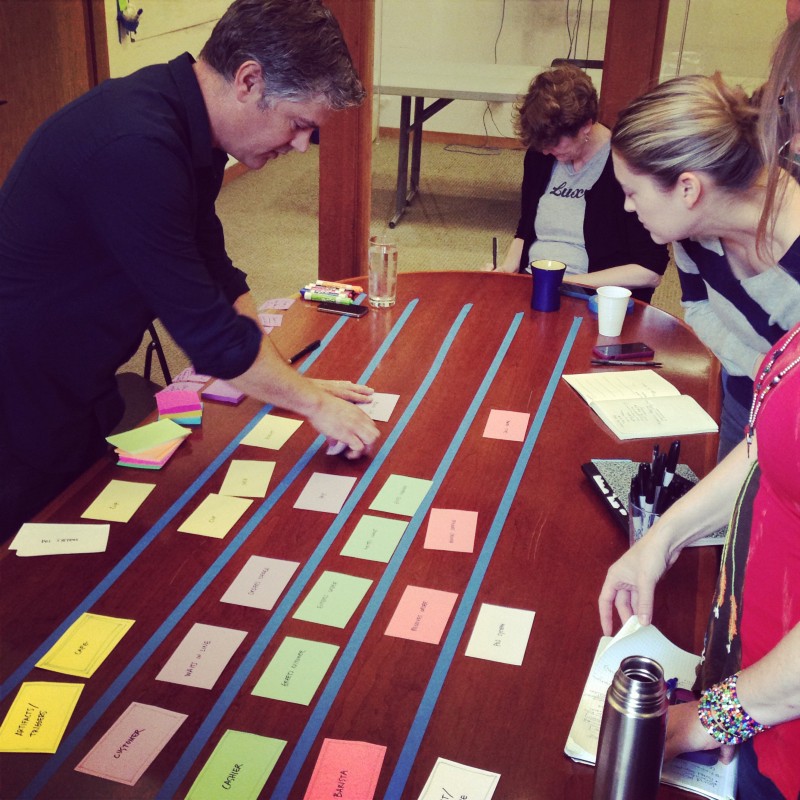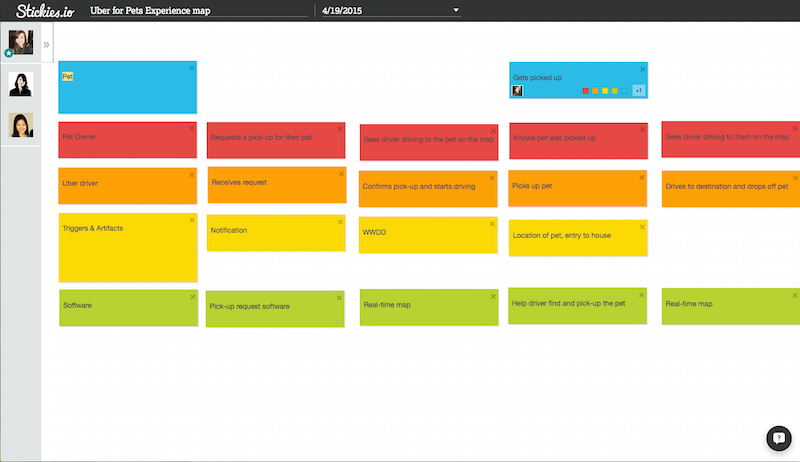Habits of Effective Teams
Have you ever worked on a team that went off the rails? Product teams need lots of support to run efficiently. You need to move fast, but you also need to be aligned in order to build successful products. Here are a few activities we use to keep our teams moving. We often facilitate them in Stickies.io, a product we built for collaboration, but any of these activities could also be done using analog sticky notes.
When you need to generate ideas
Rapid Rounds
We like to structure brainstorming sessions to help get the entire team working together towards a unified goal. We set a timer for 3-5 minutes to challenge ourselves to think fast and broad. Then, we review the ideas and do another rapid round, with 2-4 minutes this time. Finally, we give all team members 3 votes and prioritize our ideas based on votes. The sequence looks like this:
- Introduce the goal of the brainstorming session
- Run rapid rounds.You can run as many as needed. We typically reduce the time set as we go and build off of each other’s ideas.
- Set the timer for 3-5 minutes
- Individually ideate on post-its until the timer goes off
- Let everyone describe their top 3 ideas
- Give everyone 3 dots and ask them to vote on three ideas to explore further
- Arrange ideas by votes
In person, we use post-its, sharpies and sticker dots:

With a remote team, we use Stickies.io to group our ideas and the +1 feature in lieu of dot voting:

We also use different formats when brainstorming. We especially like some of the ideas in Dave Grays’s Gamestorming which you can find here. A couple common prompts in our office are:
Experiment ideation (Shown above)
Everyone writes product or customer ideas to be tested. The format to check that you’re writing testable hypothesis is:
If we (execute this activity), then we will see this (measurable result).
This exercise pairs nicely with an experience map (see below). After making an experience map, you brainstorm hypotheses that need to be tested in the flow.
Elevator pitch ideation
This method is good when deciding how to sell your product. Even post-funding, we use this activity to help us market and design products more effectively:
We help (specific audience) solve (migraine problem) with (killer solution). We’re the right people to solve it because (experience, talent or unique position).You can use the rapid rounds and dot voting techniques with either of those formats.
When you need to define your product
Experience Map
When we’re working pre-product, we use a variety of tools to map out and refine our product roadmap. One of our favorite tools is an experience map. An experience map is meant to be a lightweight artifact to document how a product or service should work that can easily adapt to new information.
The goal is to map out the customer’s experience and think through what (or who) needs to support that experience.
Here’s an example experience map for Uber:

In person, we’ll use colored notecards and create “swim lanes” for the cards to go across:

Photo by Cathrine Gunasekara
Along the side, we place cards for:
- Triggers
- Customer
- Service Provider (if applicable)
- Customer Service/Admin (if applicable)
- System (any software or automation)
Then, we go across talking step by step through a customer’s experience. We add cards to the appropriate swim lane to support that customer activity.
With a remote team, we use map out the journey using color coding and auto-arrange in Stickies.io. Here’s one we did for a product that was like Uber for pets:

After we’re done talking through the experience, we walk through the map and challenge the team to reduce the cards. Asking ourselves “Would the product still solve the problem if we take out x?”
You can take your experience map into your favorite project management tool (ours is Pivotal Tracker) and begin to write user stories. If you feel you need more definition, you can expand the cards into a story map (shout out to Jeff Patton!)
When things feel like your team is slowing down
Reflections
Retrospectives are one of the most underutilized activities to keep the team healthy. We use these weekly to get teams back into alignment by collectively reflecting on the things that are working well vs. those that are not. We feel that feedback is best given with I-statements. For example, “I sometimes feel you don’t listen to me” instead of “You don’t listen to a word I say.” The objective should be to improve the way in which the team is working together, not to single out or shame individuals.
We often use the “I like, I wish” prompt:
- Set a timer for 3 minutes
- Everyone writes their thoughts on what they “like” and what they “wish” were going better in the project
- Each person shares their reflections
- As people share, the moderator organizes likes and wishes into related groups
- Moderator highlights and celebrates what’s going well (don’t skip this, it’s very important for team moral!)
- Moderator then facilitates discussion around how to improve the way the team works together going through each set of wishes
- After the team discusses a group, the moderator writes a “we will” statement that can be used to help improve the way in which the team is working
We try to have no more than 3 “we wills” emerge out of a retrospective because it becomes tough to make a lot of changes within a week.
We tend to use digital Stickies to run retrospectives for both in person and remote team situations. Mainly because features like incognito mode and grouping make retros easy to run. Plus, the stickies automatically change color for easier sorting when you write “I like,” “I wish,” and “We will” statements to help you organize your meeting at a glance.

A retrospective using Stickies.io
Learn about more formats for retrospectives on Retromat or in Esther Derby’s Agile Retrospectives book. We think both are great resources for any project team to have on hand.
Lean Coffee
Another tactic you can use to discuss multiple topics with your team is Lean Coffee. The group creates many ideas, dot votes and then discusses the one with the most votes. You set a timer for 8 minutes and once time’s up, the group votes with their thumbs to keep talking or move on. We see this tactic used in meetups, bookclubs and with larger teams who need to power through a lot of content.
Onward
We hope you find these activities useful and we’d be interested in hearing about what activities are working for your team. Also, try Stickies.io to gather your team around a persistent workspace. We built Stickies as our team grew and we needed a better way to collaborate. Feel free to give us feedback about this post in the comments below or on Twitter @stickiesio.
Resources
Here are some other resources for activities that we like for facilitating activities:
Conversation, Cadence and Culture – recipes for happy teams from Courtney Hemphill and Lane Halley
Blogs
Books